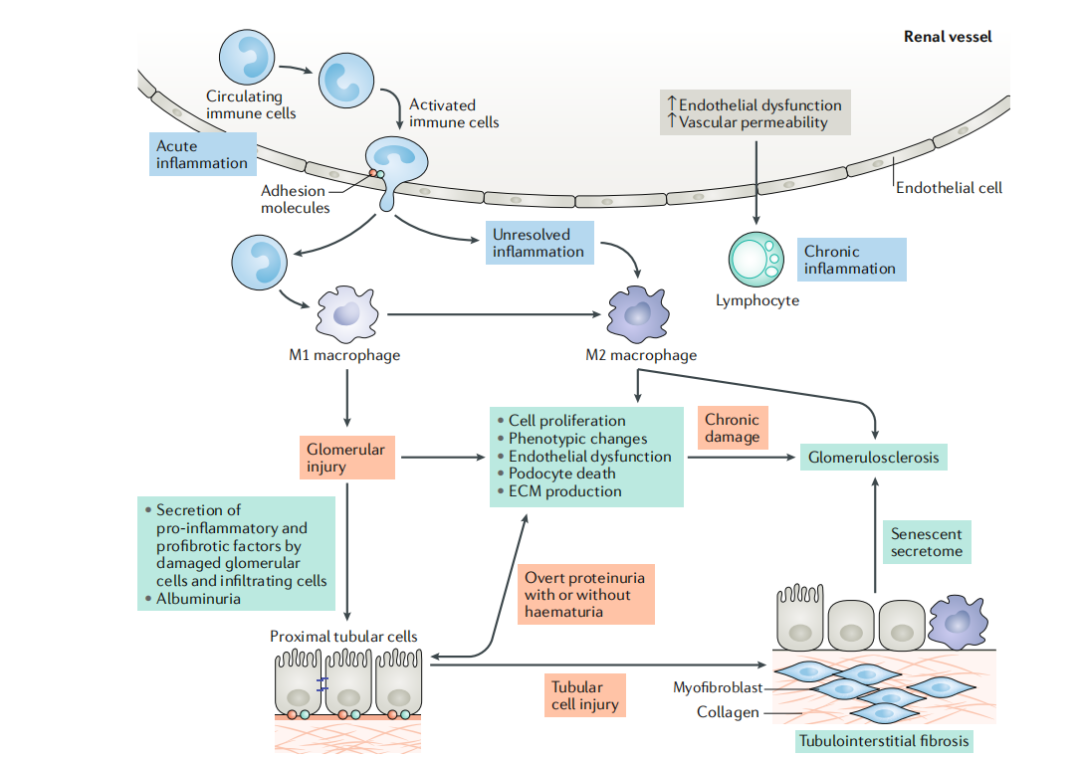Date: 2024-09-25
hits: 389
Background
Kidneys are organs that play an important role in the body's metabolic activities, specifically reflected in their functions of regulating the absorption of minerals and water, maintaining acid-base balance, and supporting the body's buffering system.
However, in China, according to recent epidemiological data, the prevalence of chronic kidney disease has significantly increased, becoming an important public health issue. At the same time, the World Health Organization reports that at least 850 million people worldwide suffer from kidney diseases, which have risen to be among the top ten causes of death globally. It is predicted that by 2040, chronic kidney disease may become the fifth leading cause of death worldwide. In the face of this severe situation, research on kidney diseases is extremely important.
In the progression of kidney diseases, studies have identified several relevant targets that play crucial roles. This article discusses representative targets in kidney diseases.
Introduction to Targets in Kidney Diseases
Chronic kidney disease is a serious urological condition that poses significant health risks. It is characterized by a high number of cases, insidious onset, diverse causes, prolonged disease history, and life-threatening complications. Therefore, actively seeking biological targets related to kidney diseases is of great practical significance for the prevention, treatment, and delay of kidney disease progression. Some common biological targets in kidney diseases are as follows:
1.MAU: Microalbuminuria refers to the presence of albumin in urine, which is different from proteinuria (the latter refers to the total protein in urine, so readers should note the distinction). Clinical studies have shown that microalbuminuria can serve as a key indicator for the early diagnosis of kidney diseases. As the disease progresses, the level of microalbuminuria will continue to rise. When the level of microalbuminuria is very high, it indicates that the pathological damage to the kidneys is irreversible at that point.
2.KIM-1: KIM-1 is a member of the T-cell immunoglobulin and mucin domain (TIM) family, and its level is commonly measured in clinical settings to predict early kidney disease. Research has indicated that KIM-1 not only plays a role in the process of kidney injury but may also be involved in kidney repair. Specifically, the expression of KIM-1 is associated with the dedifferentiation and proliferation of renal tubular epithelial cells, suggesting that it plays a regulatory role in the structural repair and functional recovery of renal tubular tissue.
Therefore, KIM-1 serves as a biomarker for kidney injury and may also be a key participant in the repair mechanisms of renal tubules.
3.NGAL: Neutrophil Gelatinase-Associated Lipocalin is a small molecular protein found in neutrophils and is a member of the lipocalin family. NGAL is an easily detectable and effective clinical biomarker for kidney disease, with elevated levels indicating compensatory defense mechanisms in the context of kidney injury. Additionally, studies have shown that measuring NGAL levels in urine is more sensitive for monitoring early kidney damage compared to measuring NGAL levels in serum. In patients with nephrotic syndrome, acute kidney injury, systemic lupus erythematosus nephritis, and diabetic nephropathy, the levels of NGAL in urine significantly increase in the early stages.
4.BMG/β2-MG: Beta-2 microglobulin is a low molecular weight protein with a molecular weight of 11,800. Changes in β2-MG levels in serum plasma can accurately reflect glomerular filtration rate (GFR), while changes in β2-MG levels in urine can indicate tubular damage. Therefore, β2-MG serves as a sensitive indicator for observing glomerular filtration rate and tubular damage.
Research has shown that changes in β2-MG levels are related to the severity of kidney disease and can serve as an indicator for monitoring early renal function impairment in kidney disease. Dynamic monitoring of β2-MG can help understand and analyze the pathological changes and prognosis of kidney disease.
5.Cys C: Cystatin C is a low molecular weight protein composed of 122 amino acids and is widely present in tissues and body fluids. The kidneys are the only organs that clear cystatin C, and its final degradation is primarily completed by renal tubules (which do not secrete cystatin C) without returning to the bloodstream. The levels of cystatin C in the serum and urine of kidney disease patients at different stages can vary significantly. Both domestic and international studies have indicated that cystatin C is an ideal and reliable endogenous marker for measuring early changes in GFR (glomerular filtration rate).
Pathways of Kidney Disease
In kidney injury, inflammatory cells are involved, as shown in Figure 1. Inflammatory cells release inflammatory factors that exacerbate kidney damage, with AngII playing an important role in this process, as illustrated in Figure 2. As the disease progresses, the changes in renal tubular cells are shown in Figure 3, revealing the transition from acute kidney injury to chronic kidney disease.



Related products:
Item No.
Product Name
Sensitivity
Related Urls
FY-EH4360
Human MAU(Microalbuminuria) ELISA Kit
0.47 pg/mL
https://www.feiyuebio.com/index/e8/47661.html
FY-EM4361
Mouse MAU(Microalbuminuria) ELISA Kit
0.1 ng/mL
https://www.feiyuebio.com/index/e9/140680.html
FY-ER4362
Rat MAU(Microalbuminuria) ELISA Kit
0.94 μg/mL
https://www.feiyuebio.com/index/e10/2887.html
FY-EH4390
Human KIM-1(Kidney Injury Molecule 1) ELISA Kit
4.69 pg/mL
https://www.feiyuebio.com/index/e8/47671.html
FY-EM4391
Mouse KIM-1(Kidney Injury Molecule 1) ELISA Kit
0.1 ng/mL
https://www.feiyuebio.com/index/e9/140690.html
FY-ER4392
Rat KIM-1(Kidney Injury Molecule 1) ELISA Kit
0.19 ng/mL
https://www.feiyuebio.com/index/e10/2897.html
FY-EH4594
Human NGAL(Neutrophil Gelatinase Associated Lipocalin) ELISA Kit
0.19 ng/mL
https://www.feiyuebio.com/index/e8/47760.html
FY-EM4595
Mouse NGAL(Neutrophil Gelatinase Associated Lipocalin) ELISA Kit
23.44 pg/mL
https://www.feiyuebio.com/index/e9/140748.html
FY-ER4596
Rat NGAL(Neutrophil Gelatinase Associated Lipocalin) ELISA Kit
37.5 pg/mL
https://www.feiyuebio.com/index/e10/2954.html
FY-EH5193
Human BMG/β2-MG(Beta-2-Microglobulin) ELISA Kit
18.75 ng/mL
https://www.feiyuebio.com/index/e8/48041.html
FY-EM5194
Mouse BMG/β2-MG(Beta-2-Microglobulin) ELISA Kit
0.02 ng/mL
https://www.feiyuebio.com/index/e9/140912.html
FY-ER5195
Rat BMG/β2-MG(Beta-2-Microglobulin) ELISA Kit
0.19 ng/mL
https://www.feiyuebio.com/index/e10/3108.html
FY-EH5595
Human Cys-C(Cystatin C) ELISA Kit
0.94 ng/mL
https://www.feiyuebio.com/index/e8/48128.html
FY-EM5596
Mouse Cys-C(Cystatin C) ELISA Kit
9.38 pg/mL
https://www.feiyuebio.com/index/e9/141120.html
FY-ER5597
Rat Cys-C(Cystatin C) ELISA Kit
0.1 ng/mL
https://www.feiyuebio.com/index/e10/3215.html
Reference:
[1] Ruiz-Ortega M, Rayego-Mateos S, Lamas S, et al. Targeting the progression of chronic kidney disease[J]. Nature Reviews Nephrology, 2020, 16(5): 269-288.





